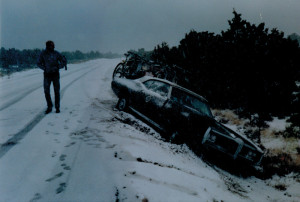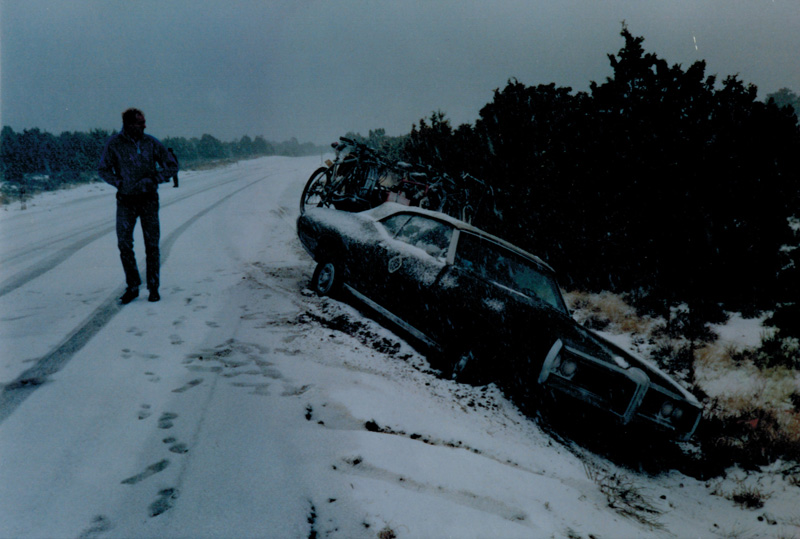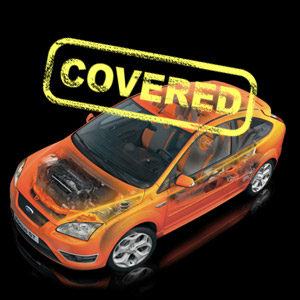Ever wonder why muscle cars – and RWD performance cars generally – suck in the snow? It’s not the rear-wheel-drive so much that leaves you spinning your wheels.
It’s the tires.
They’re wide – which is just what you want for putting hp to pavement when the pavement is not covered with snow. But when the road is covered with snow, wide tires are the worst tires – if you want to get where you’re going. They compress – and ride on top of – the snow. And thus, you slip and slide and go nowhere.
The old VW Beetle was great in the snow – despite being rear wheel drive. Because it had “pizza cutter” tires – tall and skinny. They cut right through the snow – and thus, you kept moving (usually). Same principle applies to 4WD truck or SUV, incidentally. People sometimes mistakenly fit (or order) these vehicles with the fattest tires that will fit the rims on the theory that they’ll do better in the snow.
Instead, they do worse.
There are other negatives associated with fatter/wider tires you ought to take into account, too. For instance, they increase rolling rolling resistance and add weight to the vehicle – both of which make the car slower and thirstier.
Just FYI.
Here’s another: You take your car in for service because the “check engine” light has come on. The shop fiddles with it for awhile and sends you on your way – $70 lighter in the wallet. The light’s off as you leave the parking lot – but a few miles down the road, it lights up again. Has the problem recurred? Nope. More than likely, it was never fixed in the first place. The shop may have simply plugged into your vehicle’s Onboard Diagnostics (OBD) port and, using their scan tool, cleared the trouble code (car computer-speak for one of the car’s sensors telling the central processing unit that a fault has been detected) and reset the system. The light goes out – temporarily. But it will come back on if the underlying problem hasn’t been addressed.
Cheesy Practices 101.
If this happens to you, it’s a clue that nothing was actually repaired. It is possible that another problem triggered the “check engine” to illuminate. But assuming the first problem was actually dealt with – and assuming the car was test driven by the shop after the repair – to make sure the problem they allegedly identified and repaired was in fact the problem (in which case, the “check engine” light should not have come back on) the odds are the shop is either incompetent or dishonest. You’ll know they are for sure if, when you bring your car back, they don’t agree to find/fix the problem for free – or offer to refund the money you’ve already paid.
Next up . . .
Always check the oil level after you’ve had your vehicle’s oil changed by someone else – especially if that someone else is one of those quick-lube chains or a big box store’s automotive service department. The rule goes for dealers, too. Remember what The Gipper (Ronald Reagan, for you millennials) said? Trust – but verify.
Unlike you – or me – when a volume place (that’s a quick-lube joint or a dealership) does an oil change, they very often dispense the fresh oil into the engine not bottle by bottle but via a “gun” that shoots a prescribed amount (hopefully, the correct amount) into your engine. There are several ways for this to go wrong. The tech – who might be in a hurry or just not care – could shoot in too little. Or too much. It’s easy to do, especially if the tech is in a hurry – and at quick-lube places and chain stores (and sometimes, dealerships) they are very often in a hurry – because volume is how they make their money.
It’s a lot easier than getting it wrong when the car takes 5 quarts – and you have five quarts in individual quart bottles sitting on your work bench.
Sometimes, the tech will forget that your particular car has the optional V-6 (which takes more oil, typically) than the base four cylinder engine your car might have come with. Or, he assumes the reverse. Either way, it’s bad news for your car – and for you. And once you’ve driven away, it’s also your problem – because you can’t prove the oil deficit (or surplus) was the result of the technician’s error – even if you know it was. In court, it’s He said/She said – hearsay. The shop can claim your engine leaked out the oil. Or point to some other caused. Good luck proving them wrong. 
But if you check the dipstick before you leave the joint – and catch the problem then – you’ve not only caught them red handed, you’ve just saved yourself a lot of trouble. Instead of major engine damage resulting from driving around with a half-empty (or over-full) crankcase, all you’ve got to do is correct the level there and then. Before something blows up.
And before you’re left holding the bag.
Throw it in the Woods?












tagged for emails…
It’s not just the quick lube places you have to watch either. My mom took her Toyota Starlet in to the dealer (where she bought it) religiously for routine maintenance. When it hit the ‘replace the transmission oil’ point, the dealer did so. The trouble is they didn’t tighten the drain plug. Now the transmission in that little care was tough as nails. It went several thousand miles before it finally crapped the bed. Of course the dealer denied any wrong doing, despite the fact that they were the only ones that had touched it. Her next car was a Mazda purchased from another dealer.
Let’s see:
Quick lub place changed the oil in my Dad’s car. Forgot to replace the drain plug/stripped it out putting it back in. After sitting an hour, all the oil had drained out into the parking lot.
My Stepmother had a VW diesel. She took it to the dealer for a number of years. Seems the diesel takes less oil than the gas ICE, but the shop had been billing her for the higher number of quarts of oil. She caught it when she went to a non dealer more local and notice the quart billing difference. It took her several months, but she got a refund from the dealer….
I had many rear drive cars and trucks growing up in the USSA. A fav trick in winter is to add bags of salt, or sand, to the trunk as close as possible to the axle. 300 to 400 pounds will suffice.
The bug has its engine over the drive wheels, which is what makes it like a FWD car in the snow in that respect. Rear wheel drive, even with skinny tires, has the problem that there isn’t much weight over the drive wheels. Wide of course makes things worse.
Now that doesn’t mean RWD sucks in the snow, it just means it’s different in the snow. I prefer rear wheel drive in the snow when I don’t have to deal with other people. All the stopping and going and other nonsense people do makes it difficult to drive RWD in the snow properly.
Again Brent we realize you are incapable of driving around other vehicles. I have seen your kind on the road all the time. You drive like the ones that I see driving a couple of feet behind other vehicles with your brake lights flashing every 10 seconds. Leave some spacing and you do not have problems with other drivers but we know that is not how you drive.
I used to drive rear wheel cars, vans and mini vans in the winter all the time. I never had a problem. The big thing is that weight added over the rear wheels makes a huge difference not only in starting in snow but keeping you from fishtailing. With snow tires and added weight where needed makes the rear wheel drive vehicle go through almost anything until you start pushing a lot of snow with your front end. With full sized vans, 18 inches of snow was nothing for it to go through even when it did not have snow tires.
clover,
Why do you continue to expose your ignorance before the world?
Who do you mean by “we”?
The FR-S is quite good in the snow. With 215mm wide snow tires, the limited slip diff and the weight distribution being what it is, I get around fine. I wish I had video of me passing a front wheel drive car on a hill earlier this year. He was stuck. I slowed to almost a stop to be able to see around, then hard powered up the hill, mostly for fun. Then sideways into the parking lot, at about 5mph. I love snow in the FR-S.
The first picture is so cool. Brings me back to about 35 years ago. I remember it like it was yesterday. Remind me of the time my parents and I were on a trip to Vermont. My mom ended up skidding into the median during a snowstorm. We were stuck for about 3 hours.
Our car had skinny tires though. It was a 1973 AMC Hornet Sportabout wagon with the 360 V8. That car could haul ass. Imagine what it could have done with an overdrive transmission.
One time, my dad took his 1986 Ford Taurus to a Montgomery Ward (remember those) about 22 years ago. He got the oil changed and forgot to put the cap on the engine. On his way from Florida to Connecticut, the engine died somewhere in South Carolina. Had to replace the engine.
End of story.
My favorite quickie-lube story is a “friend of a friend” thing but one I know to be true, though it happened quite a few years ago:
Woman brings her new foreign car to a quick-lube joint for its first oil change, and the “expert, trained technician” employed there quickly proceeds to drain the automatic transmission then dumps an additional 4 quarts or so of engine oil into the engine! Needless to say, she did not get very far! (The story ends with the shop paying to have the car repaired, but not until conclusion of a lengthy battle involving lawyers on both sides.)
I really don’t trust anyone else to work on my vehicles. As it happens I also prefer older models that are amenable to the shade-tree mechanic. Plusbig problem as I’m getting older, though, is the difficulty in doing some of the heavier work. At this point doing things like pulling engines and transmissions requires younger assistants.